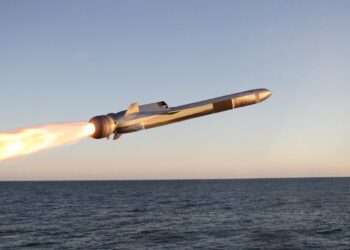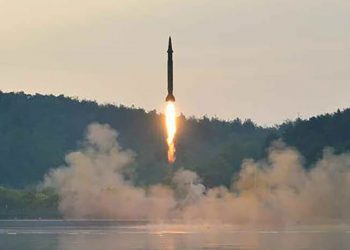,
Researchers at NASA's Dryden Flight Research Center at Edwards Air Force Base, Calif., and the Naval Air Warfare Center Weapons Division, China Lake, Calif., are investigating the use of surplus demilitarized Navy AIM-54 Phoenix air-launched missiles as possible hypersonic test platforms or testbeds. Hypersonic flight is defined as aerodynamic flight at speeds of Mach 5 or greater, and use of surplus Phoenix missiles is one of the methods being considered to obtain critical flight data in the hypersonic regime.
|
Click to Enlarge
An inert AIM-54 Phoenix missile nestled under the fuselage of NASA Dryden's F-15B aircraft is being studied as a possible test vehicle to obtain hypersonic data.
More Military Pictures
|
These missions, to be conducted over restricted military test ranges, would involve launching a missile from a NASA F-15 aircraft flying at speeds up to Mach 2.0, with the missile then accelerating to speeds up to Mach 5.0, depending on its trajectory before fuel is exhausted. The missiles would carry experimental research payloads into the hypersonic regime, something that is currently difficult to achieve.
The Phoenix missiles used for hypersonic research will have their explosive warheads removed, and their tracking and guidance systems replaced with a smaller, more lightweight guidance system. The missiles will also be heavily instrumented to obtain and transmit test data from experiments in such areas as thermal protection materials, scramjet propulsion, guidance & control, boundary layer transition and aerodynamics at hypersonic speeds.
|
Click to Enlarge
This graphic depicts the launch and flight profile for proposed hypersonic test flights of surplus Phoenix missiles launched from NASA's F-15B research aircraft.
More Military Pictures
|
At present, NASA is performing design, analysis, and testing leading up to a Critical Design Review at the end of 2007. As part of the preliminary studies, several “captive-carry” flights will be flown by the F-15 with an inactive missile with no propellant carried on the aircraft's centerline pylon to determine the performance of the aircraft when carrying the missile. The project has not been funded to conduct actual launches to obtain hypersonic flight test data, and a decision on funding such research is not expected before 2008.
When in military service, the Phoenix missile was the primary long-range air-to-air weapon carried by the Navy's now-retired fleet of Grumman F-14 aircraft. It was the first operational radar-guided air-to-air missile that could be launched in multiple numbers against different targets from an aircraft.
The missile was in operational service with F-14 squadrons from 1974 through its retirement in late 2004. The Navy has no current need for the remaining supply of Phoenix missiles and is making several available to NASA for its hypersonic research efforts.
|
Click to Enlarge
Surplus Navy Phoenix missiles like this one mounted on the centerline pylon of NASA's F-15B research aircraft may be used to acquire hypersonic flight test data.
More Military Pictures
|
A Phoenix missile is 13 feet long, 15 inches in diameter with a wingspan of 36 inches. It weighs about 1,000 lbs. in its military configuration.
Thomas Jones of NASA Dryden Flight Research Center is the principal investigator for the development of the Phoenix missile hypersonic testbed. This testbed development effort is funded by the Hypersonics Project under the Fundamental Aeronautics Program of NASA's Aeronautics Research Mission Directorate.












